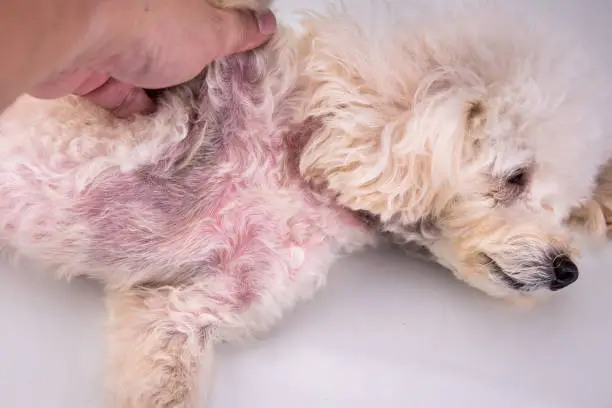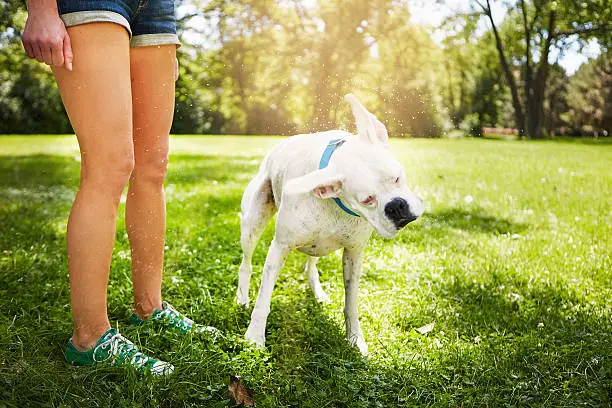Introduction
If your dog is constantly scratching, has a strong odor, or has irritated skin, a yeast infection might be to blame. Yeast infections in dogs are common and can be frustrating for both pets and owners. While veterinary treatments exist, many pet parents prefer natural remedies to help their furry friends heal. This guide will cover the best dog yeast infection home remedy, including effective natural treatments that can soothe symptoms and prevent future infections.

What Causes Yeast Infections in Dogs?
Yeast infections in dogs are caused by an overgrowth of Malassezia, a type of yeast naturally found on the skin. Under normal conditions, this yeast is harmless, but certain factors can cause it to multiply excessively.
Common Causes of Yeast Overgrowth:
- Allergies: Food and environmental allergies can trigger yeast infections.
- Weak Immune System: Dogs with compromised immunity are more prone to infections.
- Antibiotic Overuse: Antibiotics kill both bad and good bacteria, leading to yeast overgrowth.
- Humidity and Moisture: Yeast thrives in warm, damp environments like ears, paws, and skin folds.
Recognizing these causes can help you take preventive measures to keep your dog healthy.
Symptoms of Yeast Infections in Dogs
Knowing the signs of a yeast infection is key to early treatment.
Common Symptoms:
- Itchy, red, inflamed skin (often around paws, ears, and belly)
- Strong, musty odor
- Oily or greasy skin
- Chronic ear infections with dark wax and discharge
- Excessive licking and scratching
If left untreated, yeast infections can worsen, leading to discomfort and secondary bacterial infections.
Why use a dog yeast infection home remedy?
While veterinary medications like antifungal creams and medicated shampoos can be effective, home remedies offer a natural and gentle alternative.
Benefits of Home Remedies:
- Safer and chemical-free: Natural treatments avoid harsh side effects.
- Cost-effective: Many remedies use household ingredients.
- Supports long-term health: Natural solutions often improve overall immunity.
However, if your dog’s condition worsens or does not improve, consulting a vet is necessary.
Apple Cider Vinegar Treatment
Apple cider vinegar (ACV) is a powerful antifungal remedy that can help combat yeast overgrowth.
How to Use ACV:
- Topical Spray: Mix equal parts ACV and water in a spray bottle and apply to affected areas.
- Soothing Bath: Add one cup of ACV to your dog’s bathwater.
- Ear Cleaner: Use a diluted ACV solution (1 part ACV, 2 parts water) to gently clean ears.
Precautions: Never apply ACV to open wounds or raw skin, as it can cause irritation.
Coconut Oil for Yeast Infections
Coconut oil is a natural antifungal and antimicrobial remedy that can be used both internally and externally.
How to Use Coconut Oil:
- Topically: Massage a small amount onto affected areas to soothe itching.
- Orally: Add 1 teaspoon per 10 lbs of body weight to your dog’s food.
Coconut oil helps restore skin health while fighting yeast overgrowth from the inside out.
Yogurt and Probiotics for Gut Health
Since yeast infections often stem from gut imbalances, probiotics play a crucial role in restoring healthy bacteria levels.
Best Sources of Probiotics for Dogs:
- Plain, unsweetened yogurt (a spoonful a day)
- Probiotic supplements formulated for dogs
- Fermented foods like kefir
Avoid flavored or sweetened yogurts, as sugar feeds yeast.
Herbal Remedies for Dog Yeast Infections
Certain herbs have antifungal and soothing properties that can help treat yeast infections.
Top Herbal Remedies:
- Aloe Vera: Cools and soothes irritated skin.
- Calendula: Helps heal sores and inflamed areas.
- Chamomile: Reduces itching and redness.
These herbs can be used in homemade sprays or added to baths for relief.
Baking Soda and Epsom Salt Baths
A detox bath with baking soda or Epsom salt can help neutralize yeast overgrowth.
How to Prepare a Yeast-Fighting Bath:
- Add ½ cup baking soda or Epsom salt to warm bathwater.
- Let your dog soak for 10–15 minutes to relieve itching.
- Rinse well and dry thoroughly to prevent moisture buildup.
Frequent baths (2–3 times a week) can keep yeast levels under control.
Diet Changes to Prevent Yeast Overgrowth
When it comes to treating and avoiding yeast infections in dogs, diet is crucial. Since yeast feeds on sugar and carbohydrates, modifying your dog’s diet can starve the yeast and promote overall health.
Foods to Avoid:
- High-Carb Foods: Avoid grains, potatoes, and corn as they break down into sugars.
- Sugary Treats: Refrain from feeding fruits, sweetened snacks, or human foods containing sugar.
- Processed Foods: These often contain additives that can upset the gut flora.
Recommended Foods for Yeast-Prone Dogs:
- High-Quality Protein Sources: Chicken, turkey, beef, and fish.
- Low-Glycemic Vegetables: Green beans, spinach, and broccoli.
- Healthy Fats: Omega-3 oils from fish or flaxseed to reduce inflammation.
Beneficial Supplements:
- Probiotics: Maintain a healthy balance of gut bacteria.
- Digestive Enzymes: Aid in breaking down food and reducing yeast growth.
- Coconut Oil: Provides antifungal benefits and supports immune health.
A diet rich in whole, natural foods strengthens your dog’s immunity and creates an unfavorable environment for yeast.
Oregano Oil as a Natural Antifungal
Oregano oil is a potent antifungal agent that can be used to combat yeast infections in dogs. Its active component, carvacrol, helps inhibit the growth of harmful fungi.
How to Use Oregano Oil:
- Dilution: Always dilute oregano oil with a carrier oil like coconut or olive oil (1 drop of oregano oil per teaspoon of carrier oil).
- Topical Application: Apply diluted oil to affected areas using a cotton ball.
- Internal Use: Mix a drop of diluted oil into your dog’s food, but only with veterinary approval.
Precautions: Oregano oil is very strong and can cause irritation if not properly diluted. Never apply undiluted oil directly to your dog’s skin or allow them to ingest it undiluted.
Witch Hazel for Cleaning Yeaky Ears
Witch hazel is a natural astringent with anti-inflammatory properties, making it ideal for cleaning yeasty ears.
How to Use Witch Hazel:
- Dilute with equal parts water to avoid irritation.
- Soak a cotton ball in the solution and gently clean the outer ear canal.
- Avoid deep insertion to prevent ear damage.
Alternatives: You can also use a mixture of equal parts water and apple cider vinegar for ear cleaning.
Regular ear cleaning can prevent yeast buildup and maintain ear health, especially in breeds prone to ear infections.
Turmeric for Inflammation and Yeast Control
Turmeric is renowned for its anti-inflammatory and antifungal properties. Its active compound, curcumin, helps reduce yeast growth and soothes inflamed skin.
How to Use Turmeric:
- Turmeric Paste:
- Mix ½ cup turmeric powder with 1 cup water.
- Simmer until it forms a paste, adding more water if needed.
- Store in the refrigerator and apply to affected areas as needed.
- Golden Paste:
- Add turmeric paste to coconut oil and a pinch of black pepper.
- Feed ¼ teaspoon per 10 lbs of body weight daily.
Precautions: Always introduce turmeric slowly into your dog’s diet to monitor for any adverse reactions.
Preventing Future Yeast Infections
Prevention is the best strategy for managing yeast infections in dogs.
Hygiene and Grooming Tips:
- Regular Baths: Use antifungal shampoos or natural remedies like apple cider vinegar.
- Dry Thoroughly: Ensure your dog is completely dry after baths or swimming to prevent moisture buildup.
- Trim Hair: Keep hair around ears, paws, and genital areas short to reduce moisture.
Maintain a Healthy Diet:
Feeding a balanced, low-carbohydrate diet helps prevent yeast overgrowth. Including probiotics and antifungal foods like coconut oil in your dog’s diet supports overall health.
Monitor and Act Quickly:
Regularly check for signs of yeast infections, especially in high-risk areas like ears and paws. Minor problems can be avoided from becoming large ones with early attention.
Conclusion
A dog yeast infection home remedy can be an effective way to manage persistent yeast infections in dogs. By utilizing natural treatments like apple cider vinegar, coconut oil, and dietary changes, you can address yeast overgrowth without resorting to harsh chemicals. These remedies help keep your furry friend comfortable and healthy. However, always consult with a veterinarian if symptoms persist or worsen, ensuring your pet receives the best care possible.
FAQs About Dog Yeast Infection Home Remedy
1. Can I use human antifungal creams on my dog’s yeast infection?
It’s best to avoid human antifungal creams, as they may contain ingredients harmful to dogs. Opt for pet-safe products or natural remedies like coconut oil.
2. How long does it take for home remedies to work on a dog’s yeast infection?
Home remedies can take a few days to a few weeks to show improvement, depending on the severity of the infection. Consistency is key for effective results.
3. Can diet alone cure yeast infections in dogs?
While diet plays a crucial role in managing yeast, combining dietary changes with topical treatments yields the best results.
4. Is it normal for my dog’s yeast infection to smell bad?
Yes, yeast infections often produce a musty or sour odor. If the smell worsens or is accompanied by discharge, consult a vet.
5. How can I prevent recurring yeast infections in my dog?
Maintain good hygiene, provide a balanced diet, and use probiotics to support gut health. Regular vet check-ups also help in early detection and prevention.



